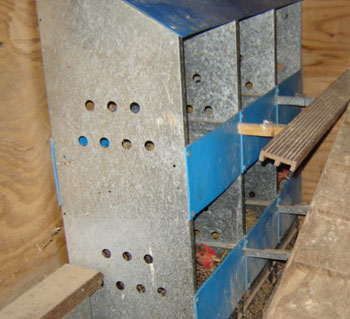 | After
Hatching, Put Baby Poultry in Brooder
...Unless you have a broody hen who will look after them. A few hens will accept
babies not their own but they need to have already been going through broody behavior.
If she has been spending many days sitting on eggs that did not hatch,
you may have a chance with her. Put them near her. You will know right away.
I
even once had 3 hens fighting over the right to mother some chicks. Finally they
decided to share them. So these lucky chicks had 3 mothers to look after them!
In the nest boxes to the left, you can see hens sitting (setting).
|
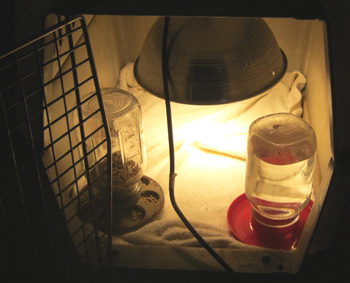

 |
You
Need a Heat Lamp to Keep Warm
If you don't have a broody hen, then after the eggs hatch put the chicks (or
ducklings or turkey poults) in a brooder with a heat lamp (incandescent). This is also what you
do with 1-day-old chicks you get from a hatchery.
You hang the heat lamp
and then raise or lower it depending upon the behavior of the baby birds. Or change
the wattage of an incandescent light bulb. Start with 100-125 watts. As they get older reduce
to 75 and then 60 watts (incandescent).
Many stores no longer sell 100/75/60/40 watt incandescent light bulbs because they are not
as energy efficient as flourescent, LEDs and halogen bulbs. However, for brooding
the inefficiency means outputting heat. So you can not use flourescent bulbs
(CFLs) or LEDs for brooding. CFLs are 67-80% percent more energy-efficient
than incandescent bulbs so produce 67-80% less heat. Halogen bulbs are somewhere
in between. Some stores and the internet have incandescent bulbs for sale.
If they huddle under the light, then they need
more heat. If they are walking around with no huddling under the lamp or crowded
in a far corner, then they are happy. They have to have a place to get away from
the heat too. They should not be in a breeze.
The photos to the left are 2 of several different types of brooders. The
first is a large dog carrying case. The second is a large plastic bin/tub.
Other photos show a hardware cloth cage. If you have animals such as cats, make sure they can not get to the baby birds.
|
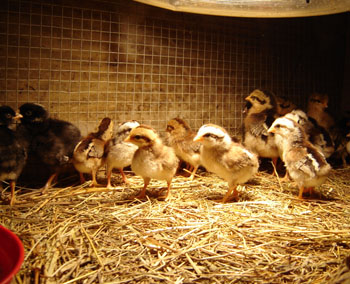
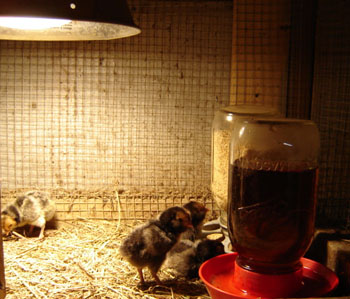 | Deep
Bedding for Babies
They need to be in a cage that rodents and other animals can not get into.
The floor can be covered with small pieces of chaff left over from animals
eating hay. You can also use straw, wood shavings/chips, or shredded paper. As
time goes on you can put new material on top of the bedding. This is called deep
bedding.
The decomposing manure creates heat for the baby birds. It
also provides natural protection from disease because it contains beneficial organisms
that the chicks eat. (Chicks forage in the bedding.) It does not smell bad. If
it smells, you need to add more bedding material.
|
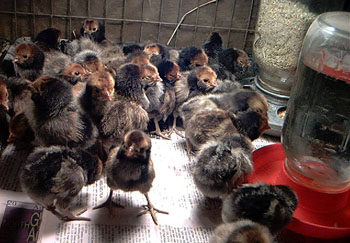
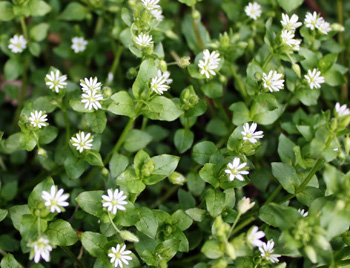 |
Chick/Duckling
Feed, Feeders and Waterers
Buy some chick feeders and waterers. Keep the water fresh.
Both chicks and ducklings eat baby chick starter feed. This is high in protein.
Ducks and ducklings need extra niacin (vitamin B3) so buy powder or capsules
to mix in their food. (Open capsules and pour in food.) Brewers yeast is
high in B3 so you can use that instead if you want. Some feed stores carry
it, or they can special order it for you. It is good to feed brewers yeast
to ducks their entire lives. Lameness in ducks is usually due to a niacin
deficiency.
Feed greens with
small leaves such as chickweed.
After 3 days put some sand (preferably coarse sand)
or baby grit in their feed. You can also put a dish of it out for them or sprinkle
some on their bedding.
If the chicks get chilled, they may get rear-end
paste up (gum up). This frequently happens when chicks are shipped. You have to
remove the paste up or the chick will die. Just pull it off. Do not wash the chick’s
rear or it will get chilled again.
|
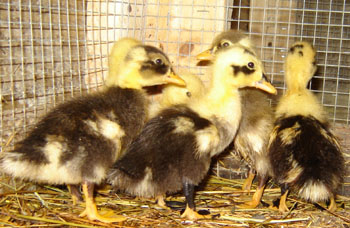 | Protected
Area Outside
After a few weeks or more depending on the weather, put them outside in a protected
area where predators and adult chickens can not get to them. They need more protection
from the elements than adult chickens.
Keep them enclosed in their shelter
for about 2 days so they know where they are supposed to roost at night. After
that their door can be open during the day. In time they can join the main flock
of birds.
|
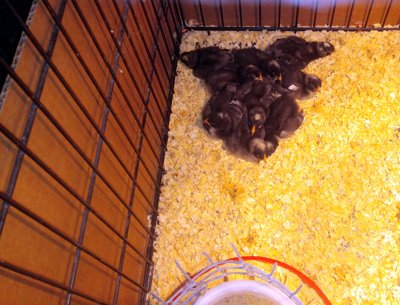 |
Brooder
Pen
This photo is from Chris and Chrissey with Dominique chicks.
"For my brooder pen, I use a medium dog kennel, about 2'x3', the wire kind. I raise it up off the floor with some 2x4s. I remove the tray that comes with the kennel and slide it under the kennel between the boards."
"I line the bottom of the kennel, where the tray was, with 1/8" (#1) or 1/4" (#2) hardware cloth. Then toss in some wood shavings. This allows absorption of the moisture and also, what doesn't get absorbed passes through the floor to the tray. I line the inside of the kennel with cardboard for draft and predator protection."
"The kennel itself is completely enclosed for protection from predators. You can hang water and feed from the top or set them on top of inverted trays." -Chris & Chrissey, Greenfield Center, New York
|
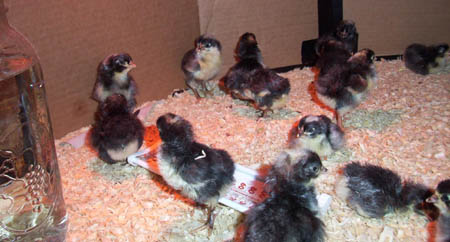
These Dominique
chicks are from hatching eggs we sent out. Everyone is happy. Photo by Mike
Paulsen, Lyles, TN.
|
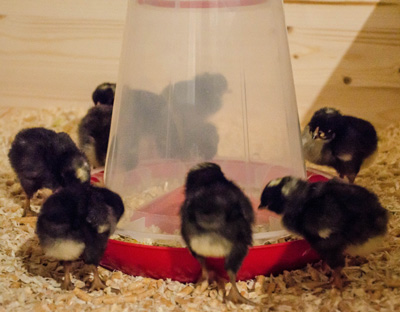
Dominique
chicks from my eggs. Photo by Mihai in Romania.
|
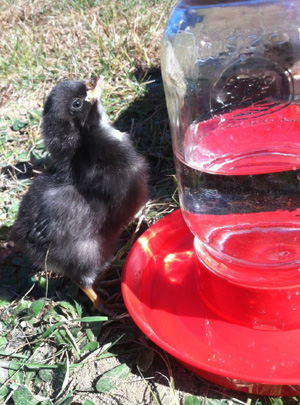
A Dominique chick
with the head up to swallow the water.
"We had good hatching from the 12 Dominique eggs you sent. 8 hatched which was very good. The chicks are doing good and growing, and should be laying in a few months." -Ernie, Macon, Georgia
|











